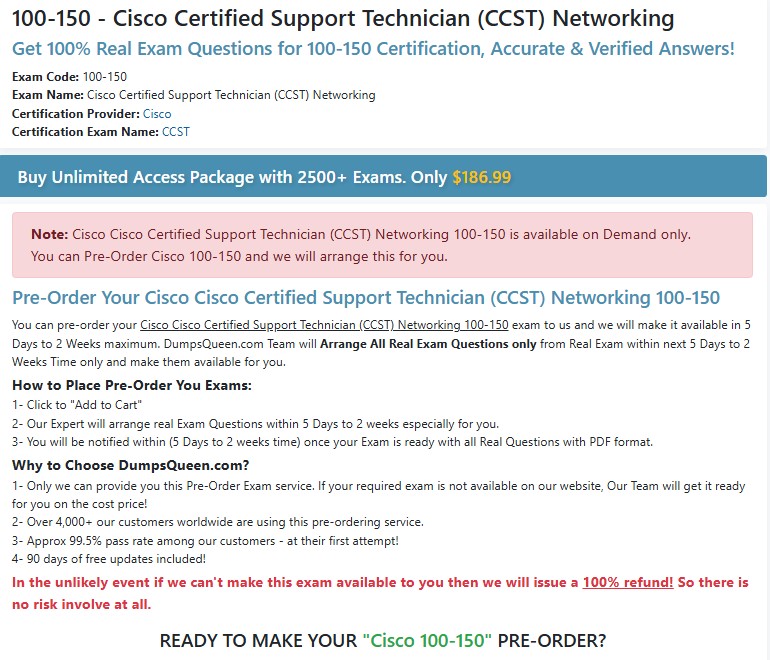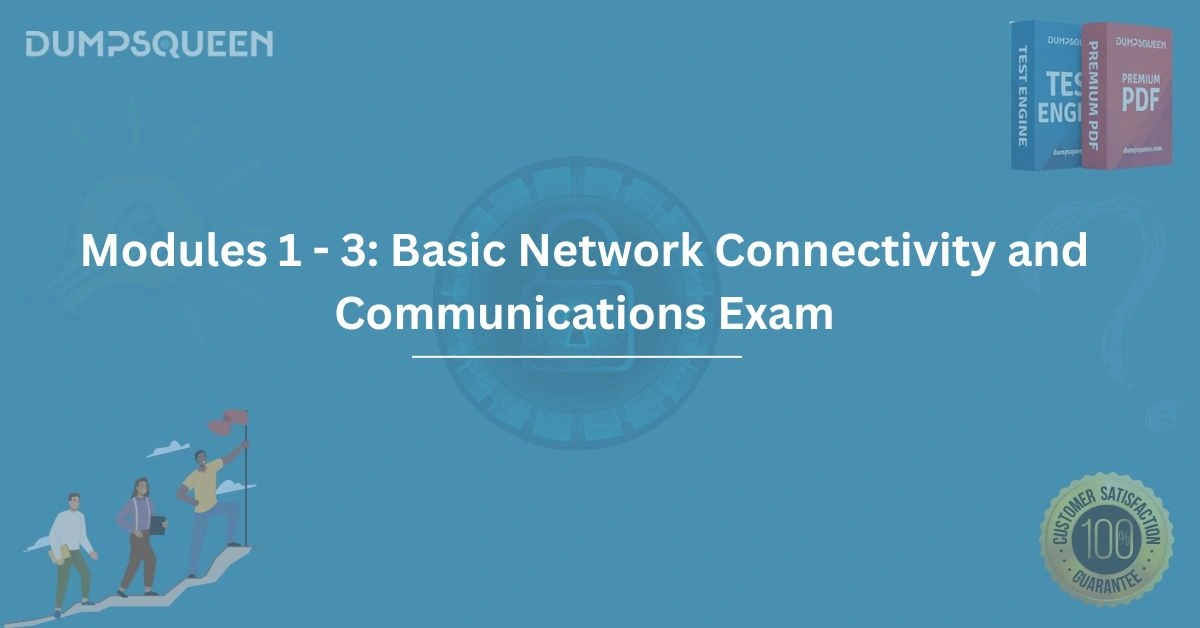Introduction
In the ever-evolving world of networking, foundational knowledge is the cornerstone of a successful career. The Cisco Certified Network Associate (CCNA) program, particularly the Introduction to Networks (ITN) course, provides aspiring network professionals with essential skills to navigate the complexities of modern network environments. Modules 1-3 of the CCNA 1 v7 curriculum, titled "Basic Network Connectivity and Communications," lay the groundwork for understanding how networks operate, communicate, and connect devices across the globe. For those preparing for the associated exam, DumpsQueen stands as a trusted resource, offering expertly crafted study materials to ensure success. This blog dives deep into the core concepts covered in Modules 1-3, explores their significance, and highlights how DumpsQueen can empower candidates to excel in the Basic Network Connectivity and Communications Exam.
Understanding the Scope of Modules 1-3
The CCNA 1 v7 curriculum is designed to introduce learners to the fundamentals of networking, and Modules 1-3 focus specifically on the principles of network connectivity and communication. These modules cover a broad spectrum of topics, from the basics of network architecture to the protocols that enable devices to exchange data seamlessly. By mastering these concepts, candidates gain a solid foundation for tackling more advanced networking topics in later modules.
Module 1, "Networking Today," introduces the concept of a connected world, emphasizing the role of networks in everyday life. It explores how devices, from personal computers to IoT gadgets, rely on networks to communicate. Module 2, "Basic Switch and End Device Configuration," delves into the initial setup of network devices, including Cisco switches and end devices, using basic Cisco IOS commands. Finally, Module 3, "Protocols and Models," examines the layered architecture of networking, focusing on the OSI and TCP/IP models and their role in ensuring reliable communication.
For exam candidates, understanding these modules is critical, as the Basic Network Connectivity and Communications Exam tests both theoretical knowledge and practical application. DumpsQueen comprehensive resources, including practice questions and detailed explanations, are tailored to help learners grasp these concepts with confidence.
The Importance of Networking Fundamentals
Networks are the backbone of modern communication, enabling everything from online shopping to global business operations. Modules 1-3 emphasize the importance of understanding how networks function at a fundamental level. For instance, the concept of a network as a "network of networks" highlights the interconnected nature of the internet, where multiple smaller networks collaborate to form a global system.
One key aspect covered in these modules is the role of end devices, such as computers and smartphones, which serve as the interface between users and the network. These devices rely on intermediary devices like routers and switches to transmit data efficiently. By learning how these components interact, candidates gain insight into the flow of data across a network, a critical skill for troubleshooting and network management.
DumpsQueen study materials break down these complex ideas into digestible segments, ensuring that learners can understand the role of each network component. Whether it’s grasping the difference between a hub and a switch or understanding how data packets travel from one device to another, DumpsQueen provides clear, concise explanations that align with the exam’s objectives.
Navigating Network Threats and Security
In today’s digital landscape, network security is a top priority. Modules 1-3 introduce candidates to common network threats, such as spyware and malware, which can compromise the integrity of a network. For example, during a routine inspection, a technician might discover software secretly collecting data about user activity—a scenario covered in the exam to test knowledge of network threats.
Understanding these threats is essential for designing secure networks. Modules 1-3 also explore concepts like intranets and extranets, which provide secure access to corporate resources for employees and external partners. An intranet, for instance, allows internal users to access confidential information, while an extranet extends limited access to trusted third parties, such as suppliers or collaborators.
DumpsQueen practice exams include scenarios that mirror real-world challenges, helping candidates prepare for questions about network security. By studying with DumpsQueen, learners can confidently identify threats and understand the network types that mitigate risks, ensuring they are well-prepared for the exam.
The Rise of Bring Your Own Device (BYOD)
One of the most significant trends in modern networking is the adoption of Bring Your Own Device (BYOD) policies. Modules 1-3 highlight how organizations are modifying their networks to allow employees to access resources from personal laptops, tablets, and smartphones. This trend increases flexibility but also introduces new challenges, such as ensuring security and compatibility across diverse devices.
BYOD requires networks to support a wide range of operating systems and applications, making it essential for network professionals to understand how to configure and manage such environments. The exam tests candidates’ knowledge of BYOD and its implications, asking them to identify the networking trends that enable this practice.
DumpsQueen resources provide in-depth coverage of BYOD, including case studies and practice questions that explore its benefits and challenges. By studying with DumpsQueen, candidates can master the nuances of BYOD and apply their knowledge to real-world scenarios, giving them an edge in the exam.
Configuring Network Devices with Cisco IOS
A significant portion of Module 2 focuses on configuring network devices, particularly Cisco switches and end devices, using the Cisco Internetwork Operating System (IOS). This hands-on component is crucial for aspiring network professionals, as it introduces the command-line interface (CLI) used to manage Cisco devices.
Candidates learn basic IOS commands, such as entering privileged EXEC mode or navigating to global configuration mode using the configure terminal command. These skills are tested in the exam through questions that require candidates to identify the correct command or troubleshoot configuration issues.
DumpsQueen practice materials include interactive simulations that replicate the Cisco IOS environment, allowing candidates to practice commands in a risk-free setting. This hands-on approach ensures that learners are not only familiar with the theory but also confident in applying their skills during the exam.
Exploring Protocols and Layered Architectures
Module 3 dives into the protocols and models that govern network communication. The OSI and TCP/IP models are central to this module, providing a framework for understanding how data is transmitted across a network. Each layer of these models serves a specific purpose, from the physical layer, which deals with hardware, to the application layer, which interacts with user applications.
The exam tests candidates’ ability to differentiate between the layers and understand their functions. For example, the transport layer, which includes protocols like TCP and UDP, is responsible for ensuring reliable data delivery. TCP, with its sequencing and acknowledgment mechanisms, is ideal for applications requiring reliability, such as web browsing, while UDP is suited for low-latency applications like video streaming.
DumpsQueen study guides provide detailed explanations of these protocols, complete with diagrams and examples that illustrate how data flows through the layers. By studying with DumpsQueen, candidates can master the intricacies of network protocols and confidently tackle related exam questions.
The Role of ISPs and Network Topologies
Internet Service Providers (ISPs) play a critical role in connecting users to the internet, a concept explored in Modules 1-3. ISPs provide the infrastructure that enables individuals and businesses to access online resources, making them a key component of the global network ecosystem. The exam may include questions about the functions of ISPs or the types of connections they offer, such as DSL or fiber-optic.
Network topologies, such as star, bus, or mesh, are another important topic. These topologies define how devices are physically or logically connected in a network, impacting performance and scalability. Understanding the advantages and limitations of each topology is essential for designing efficient networks.
DumpsQueen resources include comprehensive guides on ISPs and network topologies, ensuring that candidates have a thorough understanding of these concepts. With DumpsQueen, learners can explore real-world applications of these topics, preparing them for both the exam and their future careers.
Why Choose DumpsQueen for Exam Preparation?
Preparing for the Basic Network Connectivity and Communications Exam requires reliable, high-quality study materials. DumpsQueen is the go-to resource for CCNA candidates, offering a range of tools designed to maximize success. From practice tests that mirror the exam format to study guides that cover every topic in detail, DumpsQueen ensures that learners are well-equipped to achieve their certification goals.
One of the standout features of DumpsQueen is its commitment to accuracy. All study materials are crafted by networking experts and regularly updated to reflect the latest CCNA curriculum. This ensures that candidates are studying the most relevant content, giving them a competitive edge.
Additionally, DumpsQueen offers flexible learning options, allowing candidates to study at their own pace. Whether you prefer to practice with online quizzes or dive into comprehensive study guides, DumpsQueen has something for every learner. The DumpsQueen is a treasure trove of resources, making it easy to access everything you need to succeed.
Tips for Excelling in the Exam
While DumpsQueen provides the tools for success, candidates can further enhance their preparation with a few strategic tips. First, create a study schedule that allocates time for each module, ensuring you cover all topics thoroughly. Focus on understanding concepts rather than memorizing answers, as the exam tests both knowledge and application.
Second, take advantage of hands-on practice. If possible, use Cisco’s Packet Tracer or other simulation tools to practice configuring switches and end devices. This practical experience will reinforce your understanding of Cisco IOS commands and network setups.
Finally, regularly test your knowledge with DumpsQueen practice exams. These tests help you identify areas for improvement and build confidence in your abilities. By simulating the exam environment, DumpsQueen ensures that you’re ready to perform under pressure.
Conclusion
The Basic Network Connectivity and Communications Exam for Modules 1-3 is a critical step toward earning your CCNA certification. By mastering the concepts of network fundamentals, device configuration, protocols, and security, you lay the foundation for a successful career in networking. With DumpsQueen as your study partner, you gain access to expertly crafted resources that make preparation efficient and effective.
From understanding the role of ISPs to configuring Cisco devices and tackling network threats, DumpsQueen study materials cover every aspect of the exam. The DumpsQueen offers a wealth of tools, including practice questions, study guides, and simulations, to help you succeed. As you prepare for the exam, trust DumpsQueen to guide you every step of the way, ensuring that you not only pass but excel in your journey to becoming a certified networking professional.
Free Sample Questions
Question 1: During a routine inspection, a technician discovers software secretly collecting data about websites visited by users. What type of threat is affecting this computer?
A) Virus
B) Spyware
C) Trojan
D) Worm
Answer: B) Spyware
Question 2: Which term refers to a network that provides secure access to corporate offices for suppliers, customers, and collaborators?
A) Intranet
B) Extranet
C) Internet
D) LAN
Answer: B) Extranet
Question 3: A large corporation has modified its network to allow users to access resources from personal laptops and smartphones. Which networking trend does this describe?
A) Cloud Computing
B) Bring Your Own Device (BYOD)
C) Virtualization
D) Software-Defined Networking
Answer: B) Bring Your Own Device (BYOD)



